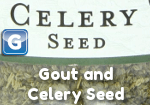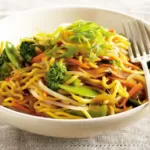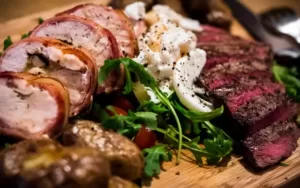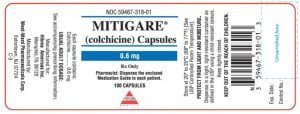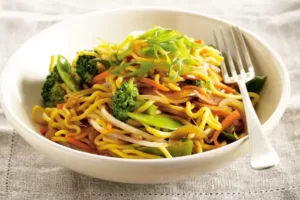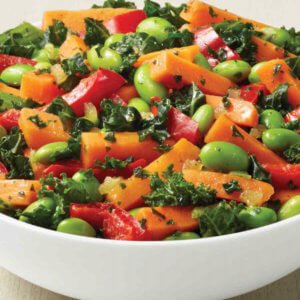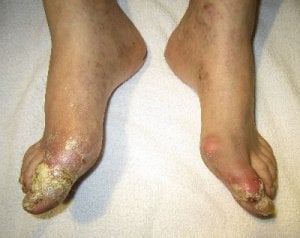Celery seeds and gout is the 86th top topic in the Gout and You series, which is based on popular searches by GoutPal visitors.
Celery seeds, and raw celery, have been popular with gout sufferers for centuries. I’ve looked for research to support this for many years, but never found anything. Until today.
Before I reveal the new research, let’s look at some facts about celery. As a vegetable, it is average, as you can see in the gout foods table for vegetables. However, as a gout treatment, we need to consider celery seeds, which are much more concentrated. In particular, we need to look at one of the components of celery seeds – a flavonoid called luteolin.
A recent report investigating celery and gout has highlighted the value of luteolin to gout sufferers. I will do a more comprehensive review of luteolin in future. For now, let’s look at the most recent report, and see why celery seeds are important to gout sufferers.
In the recently published Effect of luteolin on xanthine oxidase: inhibition kinetics and interaction mechanism merging with docking simulation, Yan and colleagues investigate the value of luteolin to gout sufferers. They state:
Luteolin is one of the major components of celery and green peppers
This is not quite true with respect to celery, as it is celery seeds that have luteolin as a major component. As you can see from the list below, celery leaves do contain luteolin, but not as a major component. Peppers are better, but the best candidates, by far, are celery seeds and radicchio.
However you get your luteolin, it is clear from this investigation, that luteolin exhibits a significant inhibitory activity on xanthine oxidase. Like many early investigations, we need researchers to follow this up with controlled trials that can assess safe dosing. So far, the only safe dosing information I can find is a reference to a human study in A toxicological investigation of a celery seed extract having anti-inflammatory activity:
in a small clinical trial of 15 patients, a dose of 1,360 mg per day provided a 45–50% decrease in pain (Paul Sweeney, unpublished observations)
Luteolin Food Sources by energy
The following table lists all foods in the USDA database that contain luteolin. To match other tables, I have formatted the data to show values per 100 calories. Please see Gout Foods Tables Introduction for an explanation of each column.
| Long_Desc | Luteolin (mg) | 100 Kcal Serve(g) | Vitamin C (mg) | PRAL Score | Iron (mg) | GoutPal Index |
|---|---|---|---|---|---|---|
| Spices, celery seed | 194.49 | 26 | 4 | -9 | 11 | -6.6 |
| Radicchio, raw | 165.13 | 435 | 35 | -21 | 2 | 23.5 |
| Thyme, fresh | 44.80 | 99 | 159 | -15 | 17 | 42.3 |
| Peppers, sweet, green, raw | 23.55 | 500 | 402 | -15 | 2 | 144.4 |
| Peppermint, fresh | 18.09 | 143 | 45 | -18 | 7 | 17.5 |
| Peppers, serrano, raw | 12.94 | 313 | 140 | -15 | 3 | 54.4 |
| Peppers, hot chili, green, raw | 9.68 | 250 | 606 | -13 | 3 | 207.9 |
| Chicory greens, raw | 9.04 | 435 | 104 | -36 | 4 | 52.9 |
| Juice, lemon, canned or bottled | 8.71 | 476 | 118 | -9 | 1 | 48.1 |
| Spices, parsley, dried | 6.76 | 34 | 43 | -18 | 8 | 15.2 |
| Celery, raw | 6.56 | 625 | 19 | -31 | 1 | 27.1 |
| Lemons, raw, without peel | 6.55 | 345 | 183 | -8 | 2 | 66.1 |
| Pumpkin, raw | 6.27 | 385 | 35 | -22 | 3 | 22.7 |
| Lettuce, red leaf, raw | 5.94 | 625 | 23 | -19 | 8 | 14.9 |
| Artichokes, (globe or french), raw | 4.89 | 213 | 25 | -11 | 3 | 12.7 |
| Kohlrabi, raw | 4.81 | 370 | 230 | -21 | 1 | 89.0 |
| Peppers, jalapeno, raw | 4.62 | 345 | 409 | -15 | 1 | 146.3 |
| Peppers, sweet, yellow, raw | 3.78 | 370 | 680 | -13 | 2 | 234.9 |
| Blueberries, frozen, unsweetened | 3.53 | 196 | 5 | -1 | 0 | 3.9 |
| Spinach, raw | 3.22 | 435 | 122 | -51 | 12 | 57.7 |
| Parsley, fresh | 3.03 | 278 | 369 | -31 | 17 | 122.2 |
| Olives, ripe, canned (small-extra large) | 2.43 | 87 | 1 | -1 | 3 | -1.7 |
| Broccoli, raw | 2.35 | 294 | 262 | -12 | 2 | 93.8 |
| Peppers, sweet, red, raw | 1.97 | 323 | 412 | -11 | 1 | 144.5 |
| Melons, cantaloupe, raw | 1.88 | 294 | 108 | -15 | 1 | 45.7 |
| Lettuce, green leaf, raw | 1.73 | 667 | 61 | -21 | 6 | 31.2 |
| Watermelon, raw | 1.53 | 333 | 27 | -7 | 1 | 14.8 |
| Rosemary, fresh | 1.53 | 76 | 17 | -13 | 5 | 6.9 |
| Grapefruit, raw, pink and red, all areas | 1.43 | 238 | 74 | -6 | 0 | 29.7 |
| Oranges, raw, navels | 1.43 | 204 | 121 | -6 | 0 | 45.0 |
| Brussels sprouts, cooked, boiled, drained, without salt | 1.39 | 278 | 172 | -12 | 3 | 62.5 |
| Cauliflower, frozen, cooked, boiled, drained, without salt | 1.26 | 526 | 165 | -9 | 2 | 62.2 |
| Kiwifruit, green, raw | 1.21 | 164 | 152 | -9 | 1 | 56.3 |
| Cauliflower, frozen, unprepared | 1.21 | 417 | 203 | -10 | 2 | 74.4 |
| Cauliflower, cooked, boiled, drained, without salt | 1.17 | 435 | 193 | -6 | 1 | 69.9 |
| Beets, raw | 0.86 | 233 | 11 | -12 | 2 | 10.3 |
| Brussels sprouts, raw | 0.77 | 233 | 198 | -12 | 3 | 70.5 |
| Cabbage, chinese (pak-choi), raw | 0.69 | 769 | 346 | -39 | 6 | 135.7 |
| Cabbage, savoy, raw | 0.67 | 370 | 115 | -13 | 1 | 46.8 |
| Peas, green, frozen, cooked, boiled, drained, without salt | 0.51 | 128 | 13 | 3 | 2 | 2.0 |
| Chives, raw | 0.50 | 333 | 194 | -16 | 5 | 69.9 |
| Lotus root, raw | 0.49 | 135 | 59 | -11 | 2 | 24.8 |
| Beans, snap, green, raw | 0.42 | 323 | 39 | -11 | 3 | 17.9 |
| Oranges, raw, all commercial varieties | 0.40 | 213 | 113 | -8 | 0 | 43.5 |
| Cabbage, raw | 0.40 | 400 | 146 | -11 | 2 | 56.3 |
| Olives, pickled, canned or bottled, green | 0.39 | 69 | 0 | -1 | 0 | 0.7 |
| Cauliflower, raw | 0.36 | 400 | 193 | -18 | 2 | 75.2 |
| Blueberries, cultivated (highbush), raw | 0.35 | 175 | 17 | -2 | 0 | 7.8 |
| Cabbage, red, raw | 0.32 | 323 | 184 | -14 | 3 | 68.6 |
| Lettuce, cos or romaine, raw | 0.29 | 588 | 24 | -25 | 6 | 19.9 |
| Carrots, raw | 0.27 | 244 | 14 | -14 | 1 | 13.4 |
| Sweet potato leaves, raw | 0.26 | 238 | 26 | -22 | 2 | 19.6 |
| Collards, raw | 0.25 | 313 | 110 | -18 | 1 | 47.3 |
| Apples, raw, with skin | 0.23 | 192 | 9 | -4 | 0 | 6.5 |
| Lettuce, iceberg (includes crisphead types), raw | 0.21 | 714 | 20 | -16 | 3 | 18.4 |
| Watercress, raw | 0.18 | 909 | 391 | -52 | 2 | 163.2 |
| Cabbage, chinese (pak-choi), cooked, boiled, drained, without salt | 0.17 | 833 | 217 | -62 | 9 | 102.0 |
| Cabbage, chinese (pe-tsai), raw | 0.13 | 625 | 169 | -29 | 2 | 75.0 |
| Tomatoes, red, ripe, canned, packed in tomato juice | 0.12 | 588 | 55 | -21 | 6 | 28.2 |
| Cabbage, cooked, boiled, drained, without salt | 0.09 | 435 | 163 | -14 | 1 | 65.0 |
| Onions, young green, tops only | 0.07 | 370 | 50 | -11 | 2 | 23.8 |
| Alcoholic beverage, wine, table, red, Cabernet Franc | 0.07 | 120 | 0 | 0 | 0 | 1.2 |
| Strawberries, frozen, unsweetened | 0.06 | 286 | 118 | -8 | 2 | 43.9 |
| Tomatoes, red, ripe, cooked | 0.06 | 556 | 127 | -19 | 4 | 53.2 |
| Juice, Cranberry cocktail, bottled | 0.06 | 185 | 78 | -1 | 0 | 28.1 |
| Gourd, dishcloth (towelgourd), raw | 0.05 | 500 | 60 | -9 | 2 | 27.4 |
| Onions, raw | 0.05 | 250 | 19 | -5 | 1 | 10.6 |
| Alcoholic beverage, wine, table, red, Cabernet Sauvignon | 0.05 | 120 | 0 | 0 | 0 | 1.2 |
| Taro leaves, raw | 0.05 | 238 | 124 | -27 | 5 | 51.4 |
| Alcoholic beverage, wine, table, red | 0.05 | 118 | 0 | -3 | 1 | 1.9 |
| Papayas, raw | 0.05 | 233 | 142 | -9 | 1 | 53.6 |
| Yardlong bean, cooked, boiled, drained, without salt | 0.04 | 213 | 34 | -9 | 2 | 16.0 |
| Mangos, raw | 0.03 | 167 | 61 | -5 | 0 | 24.1 |
| Onions, sweet, raw | 0.03 | 313 | 15 | -5 | 1 | 9.7 |
| Sweet potato, raw, unprepared | 0.02 | 116 | 3 | -7 | 1 | 4.6 |
| Apples, raw, without skin | 0.02 | 208 | 8 | -3 | 0 | 6.3 |
| Pineapple, raw, all varieties | 0.02 | 200 | 96 | -4 | 1 | 35.4 |
| Apples, Red Delicious, raw. with skin | 0.02 | 169 | 0 | -3 | 0 | 3.0 |
| Juice, grape, canned or bottled, unsweetened, without added ascorbic acid | 0.02 | 167 | 0 | -3 | 0 | 2.8 |
| Apples, Fuji, raw, with skin | 0.02 | 159 | 0 | -3 | 0 | 2.9 |
| Oil, olive, salad or cooking | 0.01 | 11 | 0 | 0 | 0 | 0.0 |
| Cranberry sauce, canned, sweetened | 0.01 | 66 | 1 | 0 | 0 | 1.1 |
| Cranberries, dried, sweetened | 0.01 | 32 | 0 | 0 | 0 | 0.3 |
| Plums, dried (prunes), uncooked | 0.00 | 42 | 0 | -6 | 0 | 2.9 |
| Raisins, seedless | 0.00 | 33 | 1 | -4 | 1 | 1.9 |
If you have any questions about celery seeds or luteolin, please ask in the gout support forum.
I will publish the 85th topic in this series tomorrow. Please subscribe to my free gout information update service, to get email notification of all new topics:
Subscribe to Free GoutPal Links
Subscription is free, and your email address is safe. Because I will never share it with anyone else. I use Gumroad to provide this service, as described at GoutPal Links Newsletter Service.
Leave Celery Seeds and Gout to browse the Gout Home Remedies guidelines.
Celery Seeds and Gout Related Topics
Please remember: to find more related pages that are relevant to you, use the search box near the top of every page.
Common Terms: Gout Home Remedies, lettuce, onion
Other posts that include these terms:
- High Alkaline Foods for Gout Diet Menu
- Gout Foods Table for Vegetables
- Foods High in Uric Acid Chart
- What Foods Cause Gout?
- Is Very Low Purine Gout Diet Possible?
- Edamame and Gout: Vegetable Medley
- Gout Friendly Salad Dressing
Please give your feedback
Did this page help you? If yes, please consider a small donation. Your donations help keep GoutPal's gout support services free for everyone.
If not, please tell me how I can improve it to help you more.
